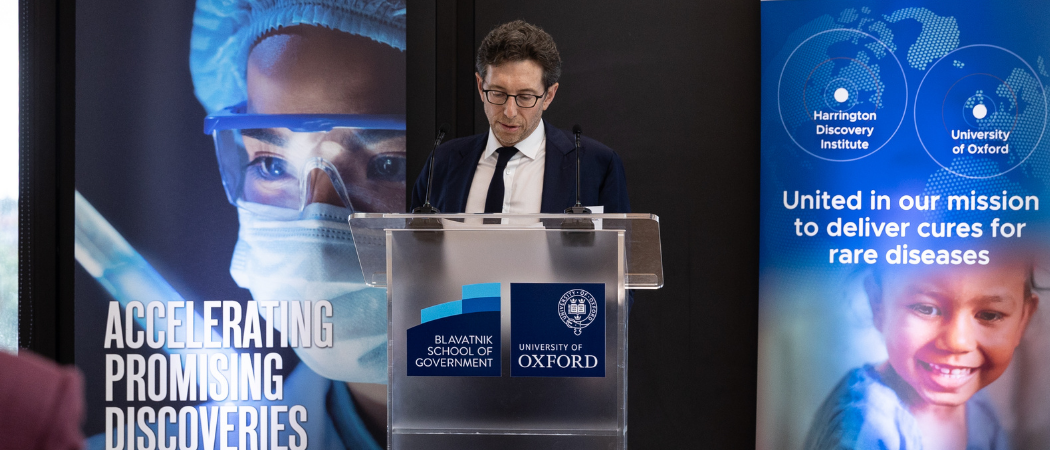Forty new rare disease programmes entering the clinic over the next decade. This is the goal of a new collaboration between Oxford University and the Harrington Discovery Institute, which aims to put up to £200M into getting projects out academic labs and into clinical development

Jonathan Stamler, president of the Harrington Discovery Institute
Nothing is easy about developing treatments for rare diseases. Patient populations are small, research funding scarce and markets limited. Yet almost all therapies that do emerge will need some form of commercialisation if they are to make it through the regulatory process and into the clinic.
A new collaboration between Oxford University and the Harrington Discovery Institute at University Hospitals in Cleveland, Ohio hopes to address these challenges. It involves the launch of a therapeutics accelerator that will identify, fund and advance innovative treatments for rare diseases developed by academic partners in the UK, US and Europe. The goal is to deliver 40 new therapies for rare diseases into clinical trials over the next 10 years.
“To do that we have a continuum of investment instruments, from charity to mission-related investing, to market-rate investing, superimposed on an alignment between academics and pharma, managed under one roof to ensure that these technologies reach meaningful milestones,” said Jonathan Stamler, president of the Harrington Discovery Institute.
The initiative comes at a time when the EU is putting in place the latest measures to promote rare disease R&D. A European Partnership on Rare Diseases to be set up as part of Horizon Europe will work with national research funding agencies to implement a long-term strategic research and innovation agenda. The partnership will issue joint transnational calls for rare disease research and develop a European Clinical Research Network to stage trials across Europe.
Lasting for 7-10 years, the partnership should have €150 million to spend, if all anticipated co-funding comes through. The sole proposal submitted by the 19 September deadline is currently being evaluated, with a decision expected by the end of January 2024.
Rare diseases are covered in a recent call from the Innovative Health Initiative, a partnership that brings together the EU and Europe’s life science industries. The aim is to establish a network of centres that will enable translational research in methods such as gene and cell therapies relevant to rare genetic diseases. Evaluation of the sole bid has been completed, but the outcome has yet to be announced.
The EU has had dedicated programmes to support rare disease research for over 20 years. It also introduced orphan drug legislation in 2000, providing incentives, including extra market exclusivity for rare disease therapies.
Into the clinic
The accelerator in Oxford builds on the Oxford-Harrington Rare Disease Centre (OHC), an R&D collaboration that began in 2019. Despite the name, it has a broader scope than traditional start-up accelerators that take in founders when they already have their eyes on the market. The aim here is to start with the final stages of academic research and take programmes through preclinical development and into the clinic.
Although the accelerator is part of the OHC, candidates can come from anywhere. “We can cast our net wider to find good projects, and that’s built into the way we have conceived the accelerator,” said Matthew Wood, professor of neuroscience at Oxford University and the centre’s director. “Over the next 10 years we are looking to have up to 100 drug development projects.” This should result in the 40 programmes reaching the clinic.
The search has already begun informally in the UK and will develop into a systematic sweep for candidates, before extending to the US and mainland Europe.
The first project to receive financial support is AlveoGene, a spinout from the UK Respiratory Gene Therapy Consortium, involving researchers from Imperial College London and the universities of Oxford and Edinburgh. This will work on gene therapies for several rare lung conditions, beginning with alpha-1 antitrypsin deficiency.
While this project has not gone through the accelerator process, it illustrates the collaborative funding model the partners have in mind, involving Oxford Science Enterprises, the Harrington Discovery Institute, and Old College Capital, Edinburgh University’s venture investment fund. It also embodies the open approach to sourcing projects.
The next candidates for funding are likely to come from existing projects supported by Harrington in the UK over the past two years, and could be announced in the first half of 2024. The first entrants for the accelerator will follow. The aim is to initiate ten programmes next year and “position them as highly promising investment opportunities in the second half of 2024 or 2025,” said Wood.
For each project, the accelerator will bring in drug development expertise that academic teams cannot usually access, such as medicinal chemistry, toxicology testing and working with regulators to design suitable clinical trials. “We aim to work as rigorously as industry standards require,” said Wood.
There will be a strict approach to cancelling programmes that are going nowhere. “Academics are often uncomfortable doing that,” Wood said. “If something doesn’t work, they see scope to investigate why it doesn’t work. We need a different mentality, and that’s what this expertise can bring.”
Weaving funds
The accelerator’s funding model weaves together public and philanthropic funding with early venture funding. “We start with charitable giving, philanthropy and grants and the like to fund the research work,” Stamler said. “We then bring in management capability, and as progress is made towards milestones, we will bring in other funding instruments.”
A significant stepping stone will be mission-related investments, an activity more familiar in the US than Europe. These are made by organisations with the goal of generating both a financial return and a positive social or environmental impact. While not demanding the same return as venture funding, this investment brings a valuable cultural change. “You get the discipline you need to create value in the development plan,” Stamler said.
The final step is to seek market investments, through partners and an impact fund that will be set up specifically to back accelerator projects. “We hope to create a mission-aligned impact fund dedicated to this rare disease initiative that will invest at market rate,” Stamler said. “We also hope that this impact fund will help create a measure sustainability.”
Although addressing small markets, there should still be a viable commercial outcome. “Fortunately, there is a relationship between impact and profit,” Stamler said. “We can be more impactful if we are more profitable, and help others do well by doing good.”
The projects the accelerator backs will look very much like embryonic start-ups, with each discovery or research asset surrounded by a team of drug developers. “We create, if you will, a non-profit company managed by a non-profit pharmaceutical entity,” Stamler said. “Every one of these technologies is entered into a portfolio, so that we can tackle a problem with multiple shots on goal, in the belief that one will get home.”
In some cases these embryonic start-ups will mature into actual companies. However, other outcomes are also possible, including licensing. There is also scope for thinking creatively about how treatments can be made commercially attractive, for example by grouping them together.
“You might put together treatments based on a common technology, or focused on a particular set of diseases that have a commonality to them,” said Wood. “For example, we could be treating 10 or 20 different epilepsies, which when you put together all the knowhow, capabilities, intellectual property and the drugs from individual projects, could become a very attractive investment opportunity.”
Work on possible business models is one of the priorities for the next six months, and this creative thinking may also extend to the accelerator itself. “There is also a longer-term question as to whether the accelerator itself is something that should be commercialised in its entirety, or whether it is just the outputs that are commercialised,” Wood said.
Transatlantic working
The international nature of the project poses some practical challenges, but there are also opportunities in having the accelerator work on both sides of the Atlantic. The US has much more funding to draw on than the UK, both when it comes to philanthropic funds and venture capital. But the UK has strong public funding, and can now also draw on EU funds, such as the Partnership on Rare Diseases currently under preparation.
Regulation is another opportunity, with Wood and colleagues already working with the UK regulator, the Medicines and Healthcare products Regulatory Agency (MHRA) on new approaches to treatments for ultra rare diseases that affect just a handful of patients.
“There is not just a very limited commercial opportunity to develop these treatments, but also the regulatory barriers are so high,” Wood said.
However, there may be hidden commonalities that can lower these barriers. “When you start to look at the underlying causes of these diseases, and all the genome data, there are actually hundreds of thousands, if not millions, of people in this situation,” said Wood. “So we want to make progress in thinking about how we can treat these very rare cases that collectively add up to a large number of patients in Europe, the US and globally.”
OHC is about to launch a pilot study that will examine how that could be achieved systematically in the UK. “That might then result in an alternative regulatory approach for these diseases, and also a way for the companies that develop the treatments to be reimbursed and the patients to be treated through the NHS,” Wood said.
The US regulator, the FDA, is seen as less open to this kind of approach. “A lot of the people who are involved in this pilot study are actually from the US,” Wood said. “They see an opportunity in doing this initial work here in the UK, to provide the proof of principle that this could work.”
Stamler also sees an opportunity for regulators to be more accommodating for rare disease treatments, for example lowering the barriers for beginning clinical trials when the numbers of possible patients may be extremely small. Regulation could also be more responsive to the technology being used.
“Many of the requirements for a drug are going to be templated,” he said. “They are going to be the same because of the vectors or similarities between many of these nucleic acids, and so won’t require some of the restrictions that are present for traditional small molecules.”
AI and computational methods will also be game-changers. “I think we are going to be able to predict, with some degree of certainty, the likelihood that you can go in and test with a measure of safety,” Stamler said. “And that will mean it does not take the six years of development needed for a small molecule before a treatment gets into a patient.”
Elsewhere in the Ecosystem…
- A project to create a pipeline of start-ups with social goals has been launched by a coalition of London universities. The hope is that this will create sufficient critical mass to sustain an investment fund that will back university social ventures emerging across the city. The project will also provide founders with legal support, business model development and mentoring. The project is led by Queen Mary University of London and University College London, and includes nine other institutions.
- Estonian-born energy storage scale-up Skeleton Technologies has raised €108 million from investors including Siemens Financial Services and Marubeni Corporation. This funding will accelerate the development of the company’s graphene-based energy storage products and finance expansion of its manufacturing capacity. Skeleton is currently building a supercapacitor factory near Leipzig, in collaboration with Siemens, and developing a novel SuperBattery.
- Battolyser Systems, a 2018 spin-out from Delft University of Technology, has signed a €40 million financing agreement with the European Investment Bank. The financing will enable the company to scale-up its production facility in Rotterdam towards mass production of its combined electricity storage and electrolyser stack system.





 A unique international forum for public research organisations and companies to connect their external engagement with strategic interests around their R&D system.
A unique international forum for public research organisations and companies to connect their external engagement with strategic interests around their R&D system.